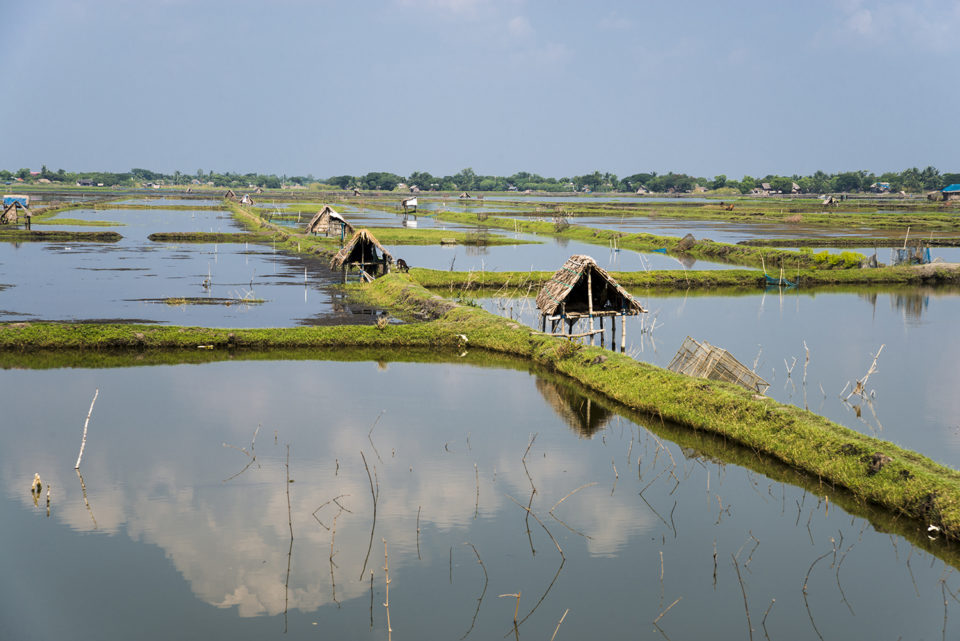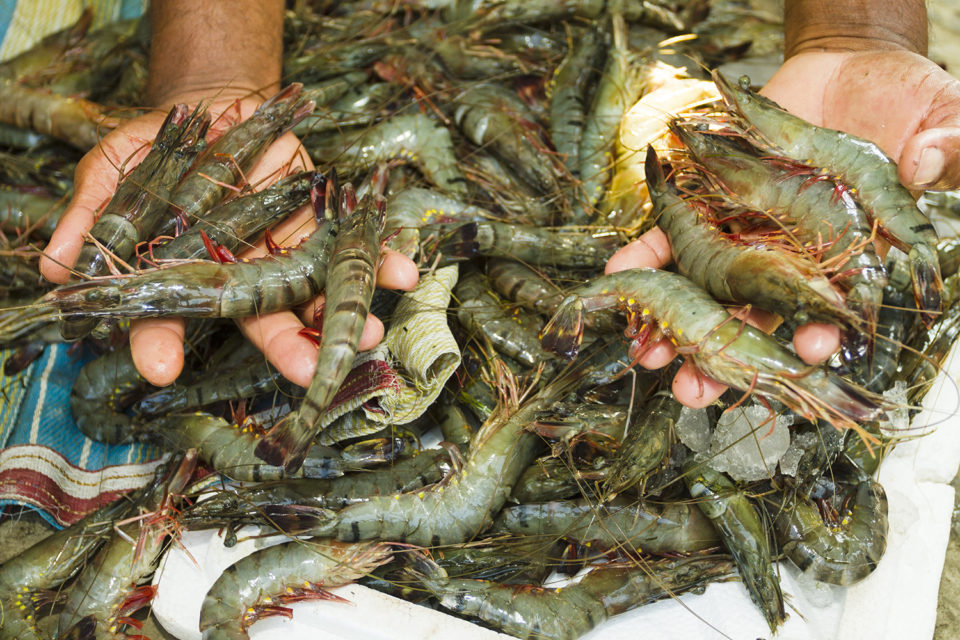Deltaic plain country learns what further industry actions could help its shrimp achieve higher market access

As a shrimp-producing nation, Bangladesh has been on a long and turbulent journey. Largely built on the extensive culture of black tiger shrimp (Penaeus monodon) – known locally as “bagda,” the industry has perpetually lagged behind its main competitors with regards to its adoption of modern technologies, farming practices and market success. Today, infrastructure shortcomings are being addressed, with improvements being made to get things on a much surer footing at all levels of the supply chain.
With the global demand for shrimp products continuing to trend upwards, Bangladeshi producers are looking to further ramp up the black tiger harvest (it has already grown eightfold in the last 30 years) and to also work collaboratively to elevate these products into higher-end markets, chiefly by building a brand for Bangladesh shrimp.
At the heart of these ambitions is a new National Action Plan (NAP). This strategy has been developed by the Department of Fisheries (DoF) in collaboration with international civil society organization Solidaridad and the Bangladesh Shrimp Fish Foundation. Essentially, the NAP seeks to position the black tigers as a premium shrimp and raise long-term demand for these products by ensuring that modern production capabilities are in place and that overseas markets’ food safety and traceability requirements are consistently being met.

Identity crisis
At present though, much of Bangladesh’s shrimp is competing in world markets at the same level as other nations’ whiteleg shrimp (Litopanaeus vannamei). It has also been losing market share to the cheaper product and is frequently sold for less than it costs to produce. The main reason for these failings is that the quality of shrimp reaching end markets hasn’t been consistently up to scratch, which has meant importers have been selling large volumes into lower value sectors, and in a few extreme cases – not selling it at all.
As more than 80 percent of Bangladeshi shrimp exports already go to EU markets, a consultation meeting involving buyers from the bloc and Bangladesh industry stakeholders and authorities was held at the end of last month in Utrecht, the Netherlands. This meeting, organized by the Seafood Trade Intelligence Portal (STIP), the Netherlands Enterprise Agency and Solidaridad, wasattended by around 20 shrimp exporters and 30 European importers. Together, theysought to establish how aligned the new NAP is with the market expectations and what further actions should be taken to overcome its dilemmas and get the shrimp into the high-value sectors that can appreciate the product and the story behind it.
Md. Raisul Alam Mondal, secretary of the Ministry of Fisheries & Livestock, conceded that for several years the Bangladesh shrimp industry had many problems meeting the demands of the EU and other export markets. But he added that through government intervention, quality issues had been addressed, particularly at the farming, post-harvest handling and processing stages of the supply chains.
“Bangladesh is producing a premium-quality shrimp – the black tiger shrimp,” he said. “Our aim now is to get better market access. Our quality, our processing and our accreditations are all in place – we have fulfilled that compliance, so we want to see a fair and equitable price from the European importers because the production costs are getting higher and higher day by day. Making it cost-effective is getting harder.”
Also attending the meeting, Sylvie Coulon of DG Sante, which is the European Commission’s department overseeing food safety and health, said there had been two recent audits of all Bangladesh food exports to the EU, the latest of which was in November 2018. She said the results from these confirmed that a “good outcome had been reached” following the “big efforts” made by the country.
Coulon told the Bangladesh delegation, “Compared to many other countries, I would say that you have done a lot to get such a satisfactory report. You have some additional progress to do, but it was a good try.”
She added her belief that in the NAP, Bangladesh “now has a plan for the future.”
Cluster model
In total, Bangladeshi shrimp production occupies around 275,000 hectares of coastal areas and comprises some 300,000 small and medium-scale farmers who are now harvesting in excess of 130,000 metric tons (MT) annually. This volume includes more than 68,000 MT of black tigers and 48,000 MT of giant freshwater shrimp (M. rosenbergii) or “galda.”
Together, bagda and galda also make shrimp by far the country’s most important agriculture-based export, accounting for more that 70 percent of the total overseas earnings. In the 2017-2018 financial year, its shrimp exports amounted to 36,167 MT with a value of U.S. $408 million. Bangladesh’s total fish and fishery product export earnings in those 12 months amounted to $515 million, based on a volume of 68,935 MT.
A key part of the NAP is to introduce the cluster farming model. This approach should be well suited to Bangladesh because its shrimp farms are inherently very small, explained Saleh Ahmed, additional director general at the DoF.
As its name suggests, cluster farming is the grouping of shrimp farms in a specific geographical area who use common resources like their water supply. They are also encouraged to act collectively rather than individually for the betterment of all. Often the overriding ambition is that farmers in these clusters receive a better price for their shrimp without the involvement of middlemen.
Rolled out in three phases, the DoF targets having 1,050 clusters comprising 26,250 farmers with a total production area of 10,500 hectares by 2020. Five years later, it expects to have 1,560 clusters with 39,000 farmers and a production area of 15,600 hectares. By 2030, this will have increased to 2,075 clusters, 51,875 farmers and 20,750 hectares of production sites.
Ahmed explained that in Bangladesh’s case, the clusters will be supported with access to a larger supply of good-quality specificpathogen free (SPF) post larvae shrimp, which will be provided by 15 approved hatcheries in 2020, 25 hatcheries in 2025, and 30 by 2030.
“We have to increase our shrimp production and also meet market requirements on quality,” he said.

Missing the mark
The meeting highlighted that an important requirement Bangladesh is still not meeting is the growing demand, particularly in EU markets, for aquaculture products that are third-party certified as being responsibly produced. While large volumes of Bangladeshi shrimp have historically gone into foodservice, Aquaculture Stewardship Council (ASC) accreditation is increasingly becoming necessary to get farmed species into European retail.
Again, the size of Bangladeshi farms – with the number of small-scale farmers far outstripping the total tonnage produced – was cited as the main impediment to certification. To-date, no single Bangladeshi farm has been or is in the process of being certified.
While certification schemes are more about market access and opening the right doors than increased prices, the Bangladesh delegation learned from their EU counterparts that it’s still an important part of the jigsaw, and that they couldn’t hope to achieve higher prices without it. They were told that this was probably the reason why a large number of farms in its main shrimp producing rivals like Vietnam, India and Indonesia had already sought certification.
Adding weight to the argument,Colruyt Group buyer Veronique Quintelier highlighted that not so long agothe Belgium retail corporation was buying large volumes of Bangladesh black tiger shrimp, but then in line with growing European consumer awareness of sustainability issues, the decision was taken to only source ASC-certified products and to also have a comprehensive view of its supply chains.
Unable to ensure full traceability and therefore guarantee that all of the Bangladeshi products that it would be supplying to its customers adhered to its new social and environmental criteria, the “hard decision” was taken to stop sourcing shrimp from the country and to turn to producers that could offer the necessary certification and full traceability, she said.
Colruyt is, however, keen to one day return to Bangladesh to support its shrimp sector. Together with Solidaridad, it has already spent two years looking at the possibility of establishing a new supply chain project. The aim is to work with farmers that it knows to meet its guidelines and then source ASC (and maybe organic) certified shrimp.
One of the central aims of this long-term plan is to be sure that its chosen farmers receive “the real, honest prices” for their shrimp, said Quintelier. The project will also seek to work with factories that will only supply products from those selected farmers and who process them according to the retailer’s specific requirements.
“It’s a difficult and complex project, but it’s high on the list for us. We want to say that we can guarantee that consumers have a product that is sustainable from start to end, which also gives an honest price to the farmers. For consumers, it’s getting more and more important to have a product that is sustainable – good for their health and also cultured and harvested in a sustainable way.”
Aligning supply with demand
Certification aside, there’s the much bigger issue whereby Bangladeshi shrimp farmers claim to be producing an excellent product but somewhere along the supply chain it goes from being a unique foodstuff to a commodity. A key contributor this problem is the amount of handling by middlemen that takes place between farm and processor.
At the consultation meeting, it was determined that shortening these supply chains would be a means to maintain quality. There was also a general acceptance that there’s a responsibility on both the Bangladesh side and with the importers to work out how to capitalize on the product instead of seeing its value downgraded.
Crucially, it was acknowledged that a lot of effort had clearly been made on the production side in terms of traceability, quality and getting a regulatory platform in place, but also that what importers are receiving continues to fall short in all these areas, and that end-markets need more effort from Bangladesh. It was therefore agreed that a new consortium of black tiger buyers and suppliers would be created. These players will now work together and develop a code of conduct for the broader industry.
In the meantime, the black tiger producers were urged not to deviate from their strategy nor branch into other species.
If you continue to focus on quality, new markets will open up, while focusing on larger sizes where vannamei cannot compete could also lead to higher prices, they were told.
More stakeholder talks are planned over the coming months and further revision of the NAP is expected.
Follow the Advocate on Twitter @GAA_Advocate
Now that you've finished reading the article ...
… we hope you’ll consider supporting our mission to document the evolution of the global aquaculture industry and share our vast network of contributors’ expansive knowledge every week.
By becoming a Global Seafood Alliance member, you’re ensuring that all of the pre-competitive work we do through member benefits, resources and events can continue. Individual membership costs just $50 a year. GSA individual and corporate members receive complimentary access to a series of GOAL virtual events beginning in April. Join now.
Not a GSA member? Join us.
Author
-

Jason Holland
Jason Holland is a London-based writer for the international seafood, aquaculture and fisheries sectors. Jason has accrued more than 25 years’ experience as a B2B journalist, editor and communications consultant – a career that has taken him all over the world. He believes he found his true professional calling in 2004 when he started documenting the many facets of the international seafood industry, and particularly those enterprises and individuals bringing change to it.
Related Posts

Responsibility
Coastal aquaculture in Bangladesh must adapt to climate change
Shrimp culture in coastal Bangladesh is threatened by climate change variables that include flooding, cyclones, drought, salinity changes and rising sea levels. Holistic planning can help reduce the impacts.

Responsibility
Bangladesh study examines potential for prawn cage farming
While Bangladesh's prawn industry is based on pond culture, a feasibility study was conducted to establish prawn cage culture to benefit resource-poor fishers and landless people.

Intelligence
Current production, challenges and the future of shrimp farming
At the Guatemalan Aquaculture Symposium in Antigua, the focus was shrimp farming in the region: production, nutrition, health management and markets.

Intelligence
Evolution of shrimp farming in Bangladesh
The social and environmental improvements – in combination with job-generating foreign investment – have led to wide acceptance of shrimp farming in Bangladesh.

